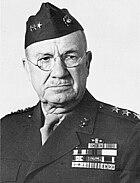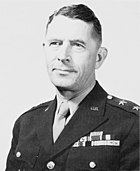
The Battle of Peleliu, codenamed Operation Stalemate II by the US military, was fought between the United States and Japan during the Mariana and Palau Islands campaign of World War II, from 15 September to 27 November 1944, on the island of Peleliu.

The VII Army Corps of the United States Army was one of the two principal corps of the United States Army Europe during the Cold War. Activated in 1918 for World War I, it was reactivated for World War II and again during the Cold War. During both World War II and the Cold War it was subordinate to the Seventh Army, or USAREUR and was headquartered at Kelley Barracks in Stuttgart, West Germany, from 1951 until it was redeployed to the US after significant success in the Gulf War in 1991, then inactivated in 1992.
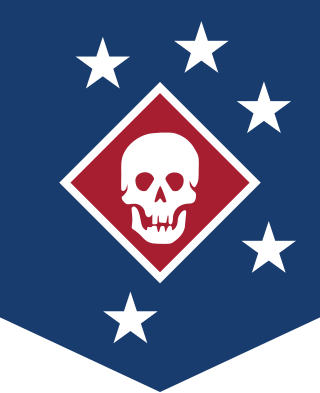
The Marine Raiders are special operations forces originally established by the United States Marine Corps during World War II to conduct amphibious light infantry warfare. "Edson's" Raiders of 1st Marine Raider Battalion and "Carlson's" Raiders of 2nd Marine Raider Battalion are said to have been the first United States special operations forces to form and see combat during World War II.
The South African 2nd Infantry Division was an infantry division of the army of the Union of South Africa during World War II. The division was formed on 23 October 1940 and served in the Western Desert Campaign and was captured by German and Italian forces at Tobruk on 21 June 1942. The remaining brigade was re-allocated to the South African 1st Infantry Division.

This is the order of battle for the Guadalcanal Campaign, called Operation Watchtower, the first major Allied offensive in the Pacific Theater of Operations in World War II. The campaign lasted from the initial American landings on 7 August 1942 until the final Japanese evacuation on 9 February 1943, a period of six months, far longer than was expected by Allied planners.

The 27th Infantry Division was a unit of the Army National Guard in World War I and World War II. The division traces its history from the New York Division, formed originally in 1908. The 6th Division designation was changed to the 27th Division in July 1917.

The Battle of Tinian was part of the Pacific campaign of World War II, fought on the island of Tinian in the Mariana Islands from 24 July until 1 August 1944. The 8,000-man Japanese garrison was eliminated, and the island joined Saipan and Guam as a base for the Twentieth Air Force.
This is the complete order of battle for the Battle of Crete and related operations in 1941.
The Malaya Command was a formation of the British Army formed in the 1920s for the coordination of the defences of British Malaya, which comprised the Straits Settlements, the Federated Malay States and the Unfederated Malay States. It consisted mainly of small garrison forces in Kuala Lumpur, Penang, Taiping, Seremban and Singapore.
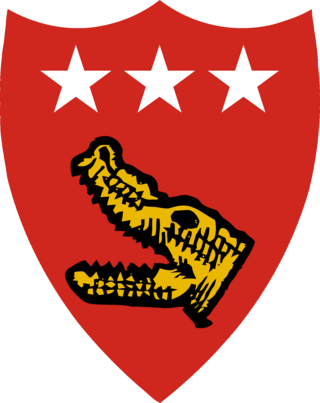
The V Amphibious Corps (VAC) was a formation of the United States Marine Corps which was composed of the 3rd, 4th and 5th Marine Divisions in World War II. The three divisions were the amphibious landing force for the United States Fifth Fleet with two goals, removal of Japanese forces from islands so U.S. Seabees could build advance bases to project US power. In doing this VAC was notably involved in the battles for Tarawa, Saipan, and Iwo Jima. V Amphibious Corps was commanded by General Holland 'Howlin Mad' Smith followed by General Harry Schmidt.
Operation Balavegaya was a combined military operation launched by the Sri Lankan military in Jaffna, the largest amphibious assault in its history. Operation Balavegaya was launched in response to the siege of Elephant Pass by the LTTE. It is believed that Operation Balavegaya was the largest and most successful military operation of the Sri Lankan military until Operation Riviresa in 1995.

The 7th (Meerut) Division was an infantry division of the Indian Army and before 1895, the Bengal Army, that saw active service during World War I.
Battle of Chosin Reservoir order of battle is a list of the significant units that fought in the Battle of Chosin Reservoir between November 27, 1950 and December 13, 1950.

The American invasion of the island of Okinawa, codenamed Operation Iceberg, took place 1 April 1945. The Japanese military was determined to inflict a casualty rate so high that the U.S. government would choose not to invade the Japanese home islands. To this end, the southern portion of the island had been covered with the most extensive system of fortifications and fields of fire yet encountered in the Pacific War.

On 21 July 1944, United States Marine and Army forces invaded the island of Guam, the southernmost of the Mariana Islands chain in the Central Pacific, with the intent to take control of the island from the Imperial Japanese Army. Operation Forager II, as it was called by American planners, was a phase of the Pacific Theatre of World War II.

The 54th Infantry Division is an Infantry division of the Indian Army. The Division was raised as an Infantry Division, but was converted into a Reorganised Amphibious Formation (RAMFOR) in 2011. It is currently the only division of the Indian Army which carries out Amphibious warfare. The division is headquartered at Secunderabad in Telangana and is a part of XXI Corps. The Division is commanded by an Officer of the rank of Major General titled General Officer Commanding (GOC).
The Battle of Hong Kong was one of the first battles of the Pacific War in World War II.

On February 19, 1945, men of the United States Marine Corps invaded the island of Iwo Jima, part of the Volcano Islands chain, in the North Pacific. This invasion, known as Operation Detachment, was a phase of the Pacific Theatre of World War II. The American goal was to establish multiple airfields that would allow escort fighters to accompany long-range bombers in their attacks on the Japanese home islands, as well as providing a place for damaged bombers to land on the return flight.
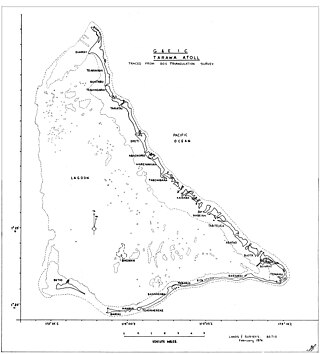
On 10 November 1943, men of the United States Marine Corps invaded the island of Betio, located at the southwest corner of Tarawa Atoll in the Gilbert Islands chain in the Central Pacific. This invasion, known as Operation Galvanic, was a phase of the Pacific Theatre of World War II.

On 15 September 1944, United States Marine Corps forces landed on the southwestern shore of the island of Peleliu in the Palau island chain, 470 nautical miles due east of the Philippine island of Mindanao. This action, called Operation Stalemate II by American planners, was a phase in the Pacific Theatre of World War II. Whether possession of the island was necessary for the Allied cause has been the source of much controversy.




